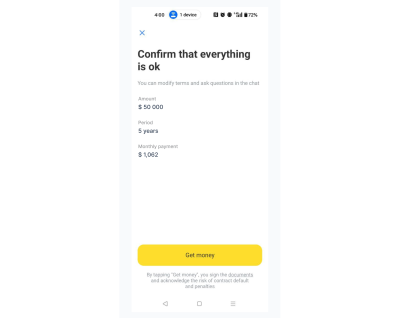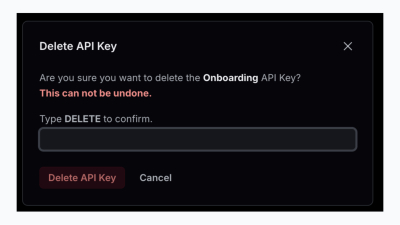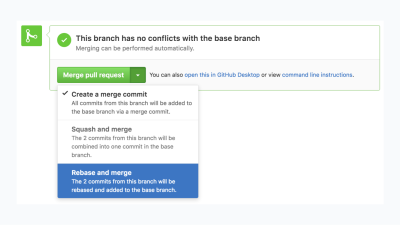- 21 min learn
- User Interface,
User Ride,
Kind
By definition, an interface is a layer between the user and a tool, serving the aim of conversation between them. Interacting with the interface in most cases requires users to plan certain actions.
Somewhat a pair of actions can lead to replace outcomes, a pair of of which would perhaps be well-known.
While we usually want to provide extra safety in case users strive to plan awful or irreversible actions, It’s accurate to have in mind that one of the ten usability heuristics called “Error Prevention” says:
“Precise error messages are fundamental, however essentially the most easy designs carefully discontinue considerations from occurring in the first predicament. Either score rid of error-inclined situations or take a look at for them and modern users with a affirmation likelihood earlier than they decide to the motion.”
What Is A Terrible Motion?
Surprisingly, after we talk about awful actions, it doesn’t necessarily mean that one thing is being deleted.
Here’s an instance of a foul motion from the banking utility I exercise:

The bank well-liked a loan for me, and as rapidly as I clicked “Rating Money,” it supposed that I had signed the essential documents and well-liked the loan. All I the truth is possess to make a selection up is faucet the yellow button, and I’ll score the money.
Due to an unintended faucet, it’s likely you’ll moreover stay up taking a loan at the same time as you occur to didn’t intend to, which is why this motion would perhaps moreover merely also be knowing about fundamental and awful.
Due to this truth, a foul motion doesn’t necessarily mean deleting one thing.
Some examples would perhaps moreover merely consist of the following:
- Sending an email,
- Placing an utter,
- Publishing a put up,
- Making a bank transaction,
- Signing an accurate doc,
- Completely blocking a user,
- Granting or revoking permissions.
Programs To Verify Terrible Actions
There are many how one can discontinue users from shedding their files or taking irreversible actions unintentionally. One approach is to request users to explicitly verify their actions.
There are several systems to put in force this, each and every with its beget mavens and cons.
Modal Dialogs
First of all, we must imprint the variation between modal and non-modal dialogs. It’s better to imagine modality instruct since dialogs, popups, alerts — all of these would perhaps be presented both in the modal instruct or no longer. I will exercise the length of time dialogs as a on each day basis reference, however the predominant phrase right here is modality.
“Modality is a make approach that gifts exclaim in a separate, dedicated mode that stops interaction with the mum or dad survey and requires an explicit motion to brush off.”
Modal dialogs require instant user motion. In other words, it’s likely you’ll perhaps perhaps no longer continue working with an utility until you reply in some approach.
Non-modal dialogs, on the opposite hand, allow you to retain using the utility with out interruption. A frequent instance of a non-modal ingredient is a toast message that appears in the corner of the show and doesn’t require you to make a selection up anything to continue using the app.
When old effectively, modal dialogs are an efficient blueprint to discontinue unintended clicks on awful actions.
The predominant challenge with them is that in the event that they’re old to verify routine actions (corresponding to marking a job as carried out), they can trigger irritation and abolish a addiction of mindlessly confirming them on autopilot.
Nonetheless, this is one of essentially the most standard systems. Besides, it’s going to moreover merely also be mixed with other systems, so let’s dive into it deeper.
When To Spend Them
Spend modal dialogs when a user motion will possess severe penalties, in particular if the stay outcome of the motion is irreversible. Long-established cases consist of deleting a put up or challenge, confirming a transaction, and loads others.
It is miles dependent on what extra or much less motion users are making an strive to take, however the predominant ingredient to take into memoir is how severe the penalties are and whether the motion is reversible or no longer.
Issues To Preserve In Mind
- Steer certain of imprecise language.
If you occur to request users, “Are you certain?” likelihood is, they’d moreover merely no longer possess any doubts. - Within the title, specify what exactly will occur or which entity would perhaps be affected (e.g., challenge name, user name, sum of cash).
- Present an icon that indicates that the motion is awful.
It each and every increases the possibilities that users won’t robotically verify it and is accurate for accessibility reasons (folks with colour blindness will peek the icon despite the truth that it appears grey to them, signaling its significance). - Within the outline, be explicit and highlight the essential files.
- The CTA button must moreover pick up a be aware that displays the motion.
In desire to “Certain” or “Verify,” exercise extra descriptive choices bask in “Delete,” “Pay $97,” “Dangle Transaction,” “Ship Message,” and loads others — including the entity name or sum of cash in the button is moreover helpful. Evaluate: “Verify” versus “Pay $97.” The latter is much extra explicit.

Nonetheless, this is perhaps no longer sufficient.
In some cases, it’s likely you’ll moreover merely require an extra motion. A frequent respond is to request users to form one thing (e.g., a challenge name) to unblock the CTA button.
Here are a pair of examples:
ConvertKit asks users to form “DO IT” when casting off subscribers.
Reliable tip: Divulge that they placed the buttons on the left facet! Here’s a nice instance of making exercise of proximity legislation. It appears cheap for the reason that post button is closer to the abolish (despite the truth that it consists of finest one enter).

Resend asks users to form “DELETE” in the event that they’re making an strive to delete an API key, which would perhaps moreover possess very severe penalties. The API key would perhaps be old in replace your apps, and also you don’t are making an strive to shatter anything.

This modal is one of essentially the most easy examples of following essentially the most easy practices:
- The title says what the motion is (“Delete API Key”).
- Within the textual exclaim, they mentioned the name of the API Key in bold and in a undeniable colour (“Onboarding”).
- The red label that the motion can no longer be undone makes it clearer that this is a severe motion.
- Extra motion is required (typing “DELETE”).
- The CTA button has each and every a colour indicator (red in most cases is old for negative actions) and a lawful label — “Delete API Key”. No longer a on each day basis be aware, e.g., “Verify” or “Delete.”
Survey that Resend moreover areas buttons on the left facet, accurate as ConvertKit does.
Divulge: While on the total disabling post buttons is believed about corrupt prepare, this is doubtless one of many cases where it is appropriate. The dialog’s request is clear and easy each and every in ConvertKit and Resend examples.
Moreover, we would perhaps skip the post button altogether. This is applicable to cases where users are requested to enter an OTP, PIN, or 2FA code. For instance, the bank app I exercise doesn’t even possess a log in button.
On the one hand, we aloof request users to plan an extra motion (enter the code). On the opposite hand, it eliminates the necessity for a extra click on.

Accessibility Issues
There is ongoing debate about whether or no longer to consist of a post button when entering a straightforward OTP. By “uncomplicated,” I mean one which consists of 4-6 digits.
While I’m no longer an accessibility professional, I don’t look any main downsides to omitting the post button in easy cases bask in this.
First, the OTP step is in most cases an intermediate segment of the user drift, which approach a abolish with four inputs appears throughout some route of. The first enter is robotically centered, and users can navigate by them using the Tab key.
The predominant level is that, as a result of little amount of files required (four digits), it is in overall acceptable to auto-post the abolish as rapidly because the digits are entered, despite the truth that a mistake is made.
On the one hand, if we care about accessibility, nothing stops us from offering users retain a watch on over the inputs. On the opposite hand, auto-submission streamlines the route of in most cases, and in the uncommon tournament of an error, the user can with out anguish re-enter the digits.
Hazard Zones
For essentially the main actions, it’s likely you’ll moreover merely exercise the so-called “Hazard zone” pattern.

A frequent blueprint to put in force this is to both possess a dedicated page or predicament the dwelling of actions on the bottom of the settings/memoir page.
It would perhaps moreover pick up one or extra actions and is in overall mixed with other systems, e.g., a modal dialog. The extra actions you’re going to possess, the extra doubtless you’ll need a dedicated page.

When To Spend Them
Spend a Hazard Zone to neighborhood actions that are irreversible or possess a excessive doable for files loss or fundamental outcomes for users.
These actions in most cases consist of issues bask in memoir deletion, files wiping, or permission changes that would perhaps well moreover possess an impact on the user’s entry or files.
Issues To Preserve In Mind
- Spend colors bask in red, warning icons, or borders to visually differentiate the Hazard Zone from the comfort of the page.
- Each and every motion in the Hazard Zone must possess a undeniable description of what’s going to occur if the user proceeds so as that users imprint the functionality penalties.
- Inquire of users for extra effort. Most frequently, the actions are irreversible and tense. In this case, it’s likely you’ll moreover merely request users to repeat their password or exercise 2FA because if any individual else gets entry to the page, this would perhaps well no longer be that uncomplicated to make a selection up the horrid motion.
- Preserve finest the truth is well-known actions there. Steer certain of making a hazard zone for the sake of having one.
Inline Guards
Objective no longer too long in the past, I learned that some apps possess started using inline affirmation. This approach that at the same time as you occur to click on on a foul motion, it changes its label and asks you to click on again.
This pattern is old by apps bask in Zapier and Typefully. While first and predominant it appears helpful, it has sparked replace debate and questions on X and Linkedin.
When To Spend Them
Here’s for non-well-known actions that would perhaps be by chance executed, in most cases because of a misclick.
There used to be a anguish mentioned by the neighborhood of designers referring to the case of users aloof being in a dwelling to make a selection up the motion by double-clicking.
Nonetheless, there are three issues to imagine:
- This extra or much less affirmation is helpful for actions that have to no longer awful, however on the same time, it’d be better to request for an extra effort.
- Ideally, we must provide an likelihood to undo the motion or push the deleted merchandise to an archive page (in case we delete one thing). Here’s a accurate combination to make a selection up certain users are actual.
- The aim of inline affirmation is to discontinue unintended clicks, contrasting with cases where we alert users to the intense penalties of their actions.
Even though the Jakob’s legislation says that
“Users employ most of their time on other sites. This approach that users prefer your location to work the same approach because the total other sites they already know.”
It doesn’t mean that it’s likely you’ll perhaps perhaps no longer facilitate the utilization of an app by introducing original patterns. In every other case, the score wouldn’t evolve at all.

I’ve seen attempts to strive to fix unintended double-clicking by altering the predicament of the inline affirmation label that appears after the first click on.
Nonetheless this creates layout shifts. When users work with the app each day, it’s going to moreover merely trigger extra irritation than assist.
As an likelihood, we can solve this anguish by adding a little lengthen, e.g., 100-200ms, to discontinue double-clicking.
It moreover matters who your users are. Bear in mind the accurate ancient days after we old to click on a dozen situations to launch Web Explorer and ended up with dozens of beginning situations?
In case your aim viewers is doubtless to make a selection up this, it appears, the pattern won’t work.
Nonetheless, for apps bask in Zapier or Typefully, my assumption is that the aim viewers would perhaps moreover possess the benefit of the pattern.
Two-ingredient Authorization Affirmation
This approach involves sending a affirmation request, with or with out some extra or much less verification code, to 1 more predicament, corresponding to:
- SMS,
- E-mail,
- Authenticator app on mobile,
- Push notifications (e.g., as an replace of sending SMS, it’s likely you’ll moreover merely prefer to ship push notifications),
- Messengers.
Survey: I’m no longer talking about authentication (namely, login route of), however quite a affirmation motion.
An instance that I personally face plenty is an app for sending cryptocurrency. Since this is a sensitive request, other than submitting the requisition from an online location, I must moreover approve it by email.

When To Spend It
It would perhaps moreover merely also be old for such operations as money transfers, possession transfers, and memoir deletion (even at the same time as you occur to will possess a hazard zone). Most of us exercise this approach somewhat in most cases after we pay on-line, and our banks ship us OTP (one-time password or one-time code).
It would perhaps moreover merely crawl after the first initial safety approach, e.g., a affirmation dialog.
Because it’s likely you’ll moreover look, the systems are in most cases mixed and old together. We must no longer imagine each and every of them in isolation however quite in the context of the total industry route of.
Passkeys
Passkeys are a up to date, password-much less authentication approach designed to enhance each and every safety and user expertise.
“Passkeys are an alternative choice to passwords. A password is one thing that would perhaps well moreover merely also be remembered and typed, and a passkey is a secret stored on one’s units, unlocked with biometrics.”
There are a pair of mavens of using passkeys over 2FA, each and every by approach of safety and UX:
- Unlike 2FA, which in most cases requires entering a code from one more application or app (e.g., SMS or authenticator apps), passkeys streamline the affirmation route of. They don’t require switching between units or making an strive forward to a code to come, offering instant authentication.
- While 2FA provides extra safety, it is vulnerable to phishing, SIM-swapping, or interception. Passkeys are much extra proof against such assaults because they exercise public-non-public key cryptography. This approach no secret code is ever despatched over the community, making it phishing-resistant and never reliant on SMS or email, which would perhaps be compromised.
- Passkeys require much less psychological effort from users. There’s no want to have in mind a password or form a code — accurate authenticate with a fingerprint, facial recognition, or application-explicit PIN. This approach, we minimize cognitive load.
- With passkeys, the authentication route of is nearly instant. Unlike 2FA, where users would perhaps moreover merely want to stay up for a code or swap to 1 more application, passkeys give us the replace to verify actions with out switching context, e.g., opening your email inbox or copying OTP from a mobile application.
The passkeys are widely supported and additional and additional corporations adopt it.

Second-person Affirmation
Here’s a mechanism when two users are eager in the midst of. We would perhaps moreover merely call them initiator and approver.
In this case, the initiator makes a request to take some motion whereas the approver decides whether to verify it or no longer.
In each and every roles, a affirmation dialog or other UI patterns would perhaps be old. Nonetheless, the predominant knowing is to separate responsibilities and lower the likelihood of a corrupt decision.
In actuality, you’re going to possess doubtless encountered this approach repeatedly earlier than. For instance, a developer submits a pull request, whereas a code reviewer decides whether to verify it or decline.

When To Spend It
It is easiest suited for eventualities when the seriousness of choices requires few folks alive to.
There is a instruct analogy from staunch life. Take a peep on the image below:

The Council of Physicians reminds us that in medicines, in quest of a second conception is needed, as collaboration and various views in most cases outcome in additional told choices and better patient care. Here’s a ideal instance of when a second conception or an approver is fundamental.
Here, you’re going to build up some apps that exercise this approach:
- GitHub, as beforehand mentioned, for merging pull requests.
- Jira and other identical apps. For instance, at the same time as you occur to switch considerations by a undeniable workflow stage, it’s going to moreover merely require supervisor approval.
- Banking applications. If you own a excessive-worth transaction, it’s going to moreover be essential to envision it for appropriate considerations.
- Deel, which is a world hiring and payroll. One segment (e.g., employer) attracts up a contract and sends it to 1 more segment (e.g., freelancer), and the freelancer accepts it.
Nonetheless right here is the ingredient: We can imagine it a separate approach or quite an approach for enforcing industry logic because despite the truth that one more person confirms an motion, it is aloof a foul motion, with the finest distinction being that now it’s one more one who must approve it.
So, the total examples mentioned above have to no longer exactly a standalone explicit blueprint to provide protection to users from making rotten choices from the UI level of survey. It’s quite an approach that helps us to slice support the collection of well-known errors.
Enact We In actuality Need To Inquire of Users?
If you request users to take motion, it’s essential to be responsive to its usual aim.
The fact that users pick up actions doesn’t suggest that they pick up them consciously.
There are many behavioral phenomena that stretch from psychology, to name a pair of:
- Cognitive inertia: The tendency of an particular person to stick to familiar choices, even in the event that they put no longer appear to be accurate for the modern topic. For instance, the overwhelming majority of participants don’t learn user agreements. They merely have in mind the prolonged textual exclaim because it’s essential from the finest level of survey.
- Availability Heuristic: Of us in most cases pick up choices in accordance to files that’s with out anguish accessible or familiar to them quite than making a psychological effort. When users look the same affirmation popups, they’d moreover merely robotically bag them in accordance to their earlier profitable expertise. Pointless to reveal, in due route, it’s going to moreover no longer work, and the acceptance of required motion can lead to corrupt penalties.
- Cognitive Miser: The human thoughts is believed about to be a cognitive miser as a result of tendency of folks to mediate and solve considerations in more straightforward and much less effortful systems quite than in additional refined and effortful systems, no topic intelligence. This explains why many users accurate click on “yes” or “agree” with out carefully studying the textual exclaim.
- Somewhat a representative instance is banner blindness, despite the truth that no longer linked to affirmation however, genuinely, revolves throughout the same human habits idiosyncrasies.
An more cost effective request that would perhaps well moreover merely arise: What are the selections?
Even though we can no longer fully possess an impact on users’ habits, there are a pair of tactics we can exercise.
Delaying
In some eventualities, we can artificially lengthen the job execution in a ideal approach.
One among my well-liked examples is an app called Glovo, which is a food transport app. Let’s possess a peep on the three screens you’re going to look at the same time as you occur to utter one thing.

The first show is a cart with objects you chose to aquire (and an nerve-racking promotion of subscription that takes ⅓ of the show).
After you faucet the “verify utter” button, you’ll look the second show, which asks you whether all the pieces is accurate. Nonetheless, the data appears gradually with proceed-in animation. Also, it’s likely you’ll moreover look there’s a development bar, which is a unfounded one.
After a pair of seconds, you’ll look one more show that presentations that the app is making an strive to rate your card; this time, it’s an loyal route of. After the transaction proceeds, you’ll look the placement of the utter and approximate transport time.
Reliable tip: If you show the placement of the utter and visually highlight or animate the first step, it makes users extra assured that the utter would perhaps be completed. Thanks to the trick that’s named Goal-Gradient Enact.
You’ve accurate paid, and “one thing begins occurring” (on the least visually), which is an indication that “Oh, they possess to possess already started making ready my utter. That’s nice!”

The aim of the show with a unfounded development bar is to let users take a look at the utter fundamental points and make sure them.
Nonetheless this is carried out in a extremely aesthetic approach:
- On the first show, you click on “verify utter”. It doesn’t invoke any modals or popups, corresponding to “Are you certain?”.
- On the second show, users can look how files about their utter appears accurate away, and the scroll bar on the bottom goes extra. It appears bask in that app is doing one thing, however it absolutely’s an illusion. An illusion that makes you take one more fast possess a look at what you’ve accurate ordered.
Within the earlier version of the app, you couldn’t even skip the route of; it’s likely you’ll moreover finest damage it. Now they added the “Continue” button, which is in actuality “Certain, I’m certain” affirmation.
This approach that we return support again to the drawbacks of basic affirmation modals since users can skip the route of. Nonetheless the approach is assorted: it’s a combination of a options loop from the app and skipping the route of.
This mix makes users eavesdrop on the cope with, utter, and place on the least in most cases, and it provides them time to shatter the utter, whereas in the basic approach, the affirmation is “yes or no?” which is extra doubtless to be confirmed accurate away.
The Undo Possibility
The undo pattern enables users to reverse an motion they’ve accurate carried out, offering a security score that reduces apprehension around making errors.
Unlike affirmation modals that interrupt the workflow to request for user affirmation, the undo pattern provides a smoother expertise by allowing actions to be completed with the likelihood to reverse them if fundamental.
When To Spend It
It works completely stunning for non-negative, reversible actions &mdashl actions that don’t possess fundamental and instant penalties:
- Reversing actions when editing a doc (The beloved ctrl + z shortcut);
- Eradicating a file (if it goes to the trash bin first);
- Altering the placement of a job (e.g., at the same time as you occur to by chance marked a job completed);
- Deleting a message in a chat;
- Applying filters to a describe.
Blended with a timer, it’s likely you’ll moreover extend the collection of choices since such tasks as sending an email or making a money switch would perhaps moreover be undone.

When You Can’t Spend It
It’s no longer accurate for actions which possess severe penalties, such because the following:
- Deleting an memoir;
- Submitting appropriate documents;
- Shopping items (refund is no longer corresponding to the undo likelihood);
- Making requests for third-celebration APIs (in most cases).
How To Put in force Them?
- Basically the most typical approach that nearly all folks exercise each day is to provide a shortcut (ctrl + z). Nonetheless, it’s constrained to a pair cases, corresponding to textual exclaim editors, transferring files between folders, and loads others.
- Toasts are potentially essentially the most frequent blueprint to put in force these web and mobile apps. The finest ingredient that it’s essential to take into memoir is that it’s going to stand out sufficient to be observed. Hiding them in a corner with a little message and colour that’s no longer noticeable would perhaps moreover no longer work — in particular on huge screens.
- A straightforward respond is merely to possess a button that does the undo likelihood. Ideally shut to the button that evokes the motion that you simply certainly are making an strive to undo.
The undo likelihood is tightly linked to the knowing called subtle deleting, which is widely old in backend frameworks corresponding to Laravel.
The knowing that approach that after users delete one thing by the UI, it appears to be like to be bask in it has been deleted, however in the database, we retain the data however imprint it as deleted. The options is no longer misplaced, which is why the undo likelihood is doable since we don’t certainly delete anything however quite imprint it as deleted.
Here’s a accurate blueprint to make a selection up certain that files is by no approach misplaced. Nonetheless, no longer every desk needs this.
For instance, at the same time as you occur to delete an memoir and don’t make a selection users to revive it (perhaps because of appropriate guidelines), then you certainly must erase the data fully. Nonetheless in various cases, it would be a accurate knowing to imagine subtle deleting. Within the worst case, you’ll be in a dwelling to manually restore user files if it can’t be carried out by the UI for some reason.
Conclusion
There’s one thing I would prefer every person to take into memoir, no topic who you are or what you own.
Each and every topic is uncommon. A undeniable approach would perhaps moreover work or fail for a fluctuate of reasons. You would perhaps moreover in most cases shock why a explicit decision used to be made, however it’s likely you’ll moreover merely no longer realize how repeatedly the interface used to be revised in accordance to staunch user options.
User habits is stricken by many components, including nation, age, culture, training, familiarity with certain patterns, disabilities, and additional.
What’s needed is to close on high of issues of your files and users and be ready to answer when one thing goes rotten. Following easiest practices is fundamental, however it’s essential to aloof take a look at in the event that they work on your explicit case.
Precise bask in in chess, there are replace tips — and even extra exceptions.
Extra Reading
- Modality, Apple
- “An efficient ‘Abolish’ dialog affirmation on Web,” João Bexiga
- “Verify or undo? Which is the larger likelihood?,” Josh Wayne
- “Realizing Soft Delete and Exhausting Delete,” Suraj Singh Bisht
- “Affirmation Dialogs Can Prevent User Errors — If No longer Overused,” Jakob Nielsen
- “Microcopy for affirmation dialogues,” Kinneret Yifrah
- What’s a passkey?, passkeys.io
(vf, il, yk)






